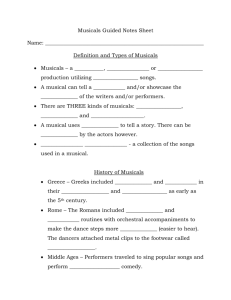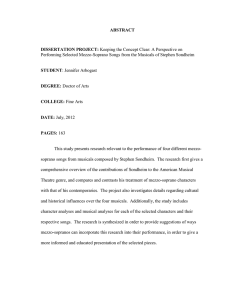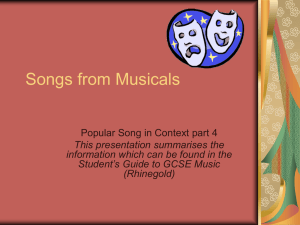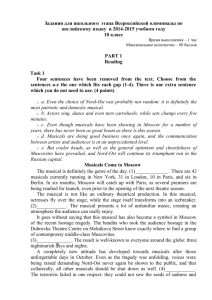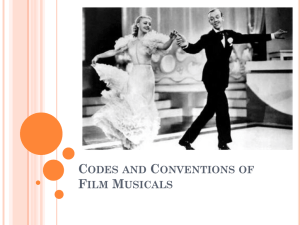Musical Theatre History: From Greek Theatre to Modern Musicals
advertisement
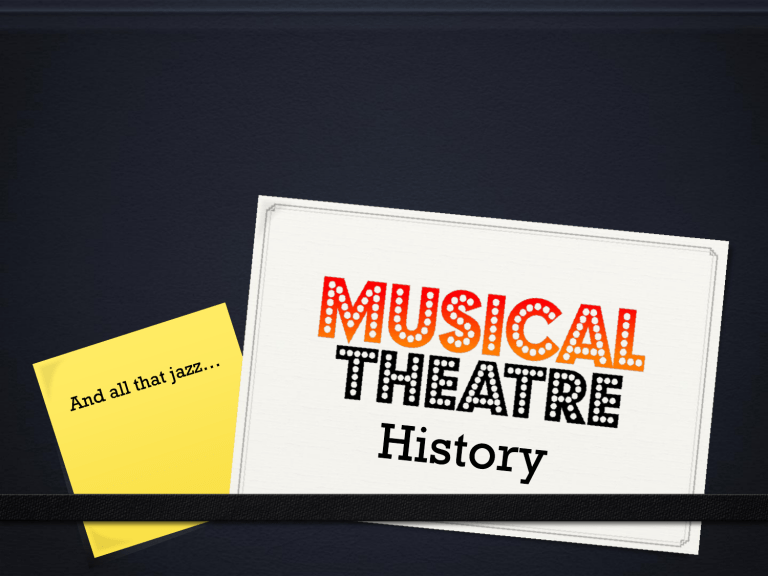
Greek Theatre - 534 BC 0 Greek Theatre was where Musical Theatre began. 0 They had a chorus which would sing songs to help tell a story. 0 Their plays would consist of religious themes and would usually use the Gods like Zeus and Hades as characters. Ballad Opera - 1728 -1750 0 Featured farcical or extravaganza plots that poked fun at popular Italian Opera- much easier for the common folk to identify with. 0 Used folk tunes from England, Scotland and Ireland but rewrote the lyrics. 0 A famous Ballad Opera is “The Beggars Opera” which is still performed on occasions today. Music Halls – 1850 ● Involved a mixture of popular songs, comedy, specialty acts and variety entertainment ● Venues would have chairs and tables that people would sit around and would chat and drink while being entertained. ● After WWI, big band acts and restrictions on drinking in the venue killed off Music Halls. Burlesque – 1860 0 Burlesque Musicals were comedy entertainment parodying well known opera or classical theatre in risque style. 0 Featured musical scores ranging from popular contemporary songs to operatic arias 0 Burlesque grew longer and longer until it became a musical that would last all evening. Vaudeville - 1870 0 Vaudeville was variety entertainment without psychological or moral intention. 0 Types of acts included musicians, comedians, trained animals, .magicians, strongmen jugglers, minstrels and impersonators. 0 Vaudeville also included freak shows and American burlesque. Daisy and Violet Hilton - Conjoined twins who toured in vaudeville and American burlesque circuits in the 1920’s and 1930’s. Harry Houdini Houdini earned his name as a magician by performing death defying magic tricks by escaping such perils as being locked in a box underwater and being buried alive. The picture depicts his death defying trick where he was locked into a milk jug filled with water and escaped! Golden Age Musical 1943-1960 0This period gave way to musicals that incorporated strong storylines into their performance. 0The songs were specifically written to fit in with a story. 0They brought in famous actors to take the lead roles. The King and I Written by: Rodgers and Hammerstein Year: 1951 Synopsis: Widowed Welsh mother Anna Loenowens becomes and governess and english tutor to the wives and children of the stubborn King Mongkut of Siam. Although her and the kings personalities clash, she works hard to prepare a party for a group of European diplomats who must change their opinion about the king. Fun Fact: In Thailand (previously Siam) the “King and I” film is banned due to the perceived disrespect to the monarchy. The “King of Siam” as portrayed in the movie is very rigid and stuck in his ways. However, the real king of Siam was a very progressive king who led the way for modernization, improved relations with the West and instituted many cultural and social reforms in Thailand. My Fair Lady Written by: George Bernard Shaw and Frederick Loewe Year: 1956 Short Synopsis: Noted phonetician Professor Henry Higgins makes a bet that he can pass off Eliza, a cockney flower girl, as a proper lady with speech tutoring. What he didn’t bet on is that he would fall in love with her. Fun Fact: The role of Eliza was originally played by Julie Andrews, but when they decided to take the show to the Silver Screen, they asked the better known Audrey Hepburn to play the role. Oliver! Written by: Lionel Bart Year: 1968 Synopsis: Oliver, an orphaned boy falls in with group of pickpockets lead by the artful Dodger and masterminded by the criminal Fagin. When Oliver is offered a home, Fagins henchman Bill Sikes plots to kidnap the boy to keep him from talking about the thievery. Fun Fact: Ten-year-old Mark Lester – who played the title role as the orphan Oliver – didn’t sing any of his songs in the film. Branded ‘tone-deaf and arrhythmic’ by the musical arranger Johnny Green, Lester’s songs were instead dubbed by the arranger’s daughter, Kathe Green. Fun Fact: Sound of Music Written by: Rodgers and Hammerstein Debut 1959 Synopsis: Based on the real life story of the Von Trapp Family singers. Maria, the tomboyish postulant at an Austrian abbey who becomes a governess in the home of a widowed naval captain with seven children, and brings a new love of life and music into the home. Fun Fact: A major plot hole in the story… If the Von Trapps had hiked over the mountains, as the story depicts,they would have ended up in Germany, near Adolf Hitler’s mountain retreat. Clearly, that was not the destination they intended. West Side Story Written by: Leonard Bernstein and Stephen Sondheim. Year: 1957 Synopsis: A modern retelling of Romeo and Juliet, true love is found despite hatred between the Jets and the Sharks, two rival gangs in New York City. Fun Fact: Originally, the story was going to be about a Catholic boy and a Jewish girl. It was decided that the whole Jewish-Catholic premise was not very fresh. Instead they decided to focus on two teenage gangs. Fiddler on the Roof Written by: Joseph Stein Broadway Debut:: 1964 Synopsis: A poor Jewish milkman, determined to find good husbands for his five daughters, consults the traditional matchmaker - and also has a word with God. Fun Fact: Out of 50 original songs written and scored, only 15 made the final cut! Contemporary Musicals 1970’s to Present Musicals in the1970’s Rock musicals like Jesus Christ Superstar, Godspell and The Rocky Horror Picture Show flourished. Stories were based on concept albums where songs fit together better as a whole rather than by themselves. 1970’s Diversity! Shows like Raisins, Dreamgirls, Purlie and The Wiz brought a significant AfricanAmerican influence to Broadway. Musicals in the 1980’s The 1980’s saw the influence of the MEGAMUSICAL which typically featured a popinfluenced score, large casts, spectacular sets and special effects like a falling chandelier in Phantom of the Opera. Big budgets were important! Chandelier Drop Musicals in the 1990’s While tickets on Broadway skyrocketed, Off- Broadway productions began to bring in more frugal theatre goers. Shows like Rent and Little Shop of Horrors were marketed to increase the popularity of musicals among a younger audience with cheaper tickets. 1990’s - Rise of Disney Musicals The 1990’s also saw the influence of large corporations on the production of musicals. The most important has been Disney Theatrical Productions which began adapting musicals for the stage starting with Beauty and the Beast, Lion King and Aida. The Lion King is the Highest grossing musical in Broadway History. Musicals 2000 - 2010 In the new century, familiarity has been embraced by producers and investors anxious to recoup their considerable investments. Some took chances on new creative material such as Urinetown, Avenue Q, American Idiot, and In the Heights. 2000-2010 Other producers took the “safe” route with revivals of familiar fare like Fiddler on the Roof, A Chorus Line, West Side Story. Some have taken adaptations of Literature like Fun Home, Wicked, and The Scarlet Pimpernel and backed the musical version. Jukebox Musicals Another trend has been to create a minimal plot to fit a collection of songs that have already been a success. This genre includes musicals like Mamma Mia (Abba), We Will Rock You (Queen) and Jagged Little Pill (Alanis Morissette). Film and TV Musicals Live action film musicals were nearly dead in the 1890s, but in 2001, there began to be a revival of the film musical with Moulin Rouge, followed by Chicago, Phantom of the Opera, Rent, and so many more, causing a landslide of successful film-adapted musicals. MUSICALS ADAPTED TO FILM LIVE Musicals on TV In 2013, NBC began a series of live television broadcasts of musicals starting with The Sound of Music. They then followed with Peter Pan Life!, Rocky Horror Picture Show: Live, and Grease: Live Video Bonus Musical Influence Musical influence has found its way into several other genres of entertainment like TV shows and Cartoons. Legally Blonde Newsies In the Heights Hairspray Wicked Avenue Q Next To Normal Spring Awakening NEW POPULAR MUSICALS
